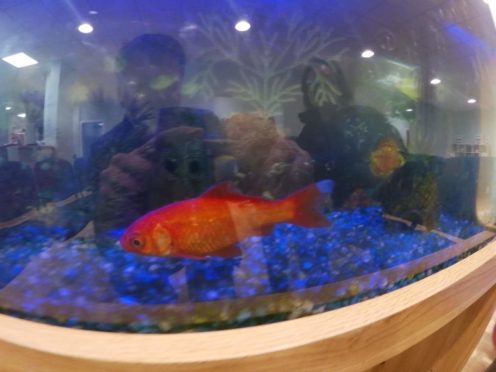In a fish tank at Dingwall Heath Centre lives a goldfish named Orange.
She (or is it he, can anyone tell?), is now at least fourteen years old.
I know this because she was given to my daughter, along with a companion named Peach, for her ninth birthday.
Orange and Peach were soon joined by my son’s fish, Apricot and finally, by the black and swishy-tailed Sharon. All four spent years amusing us as they swam in circles round their tank, which sat on a windowsill in the kitchen.
One by one, the inevitable happened. Peach was never the same after swimming head-first down the bubble pipe, Sharon developed an alarming and ultimately fatal distortion that we call scoliosis in medical practice and poor Apricot was found, one morning, floating motionless on the water’s surface.
Orange was the sole survivor and survive she did, enduring as all three children grew up and left home for further studies. It was time to pension her off. She was retired to her new home in the Health Centre, where she entertains and is gazed at by a new audience of young and old patients alike.
Orange earns her keep by providing an antidote to what might be a somewhat daunting and clinical space that would otherwise depend on random magazines and views across the fields towards the Cromarty Firth for distraction.
This waiting room is something of a liminal space, here the community meets its health service. It can feel like a gathering space where people meet and chat. But it is also a place where people sit in silence, absorbed by their own thoughts.
It is shared by all age groups and, with each person visiting their GP on average five times a year, all groups in society are represented and sit side by side. Pregnant women wait for the midwife, and all ages from babies, toddlers and children, to adults and the very elderly wait to see GPs, nurses, physios and podiatrists.
It is also a place of empty chairs, perhaps for the people whose lives are barely manageable from day to day who wait until the final crisis before being forced to seek help, or the young men whose self-perception of invulnerability is shattered by a diagnosis of diabetes that makes complying with our complex and tedious monitoring intolerable.
Most of my colleagues use an intercom to call their patients through to their surgeries. I am lucky to have a consulting room close to the waiting room, so I prefer to get up and go through to greet them myself. For me, this is the start of the consultation. I can often spot the sore back, gammy hip or gouty toe before we sit down and start talking. The time it takes for an elderly patient to rise and walk through gives a measure of frailty that helps to frame our discussion.
Sometimes, a small smile can give me a glimmer of hope that the black dog of depression is leaving a patient’s life. Occasionally the diagnosis is revealed in the shake, shuffling gait and hesitation at the point of crossing my surgery’s threshold, that the early stage of Parkinson’s Disease is becoming evident.
Some people come hastily wrapped in layers straight form their sick bed, others in the uniform of work; smart suits, paint splattered overalls, boiler-suits, a ghillie’s tweeds, supermarket-logoed blouses or street-styled teenagers. Each can signpost identity but can also deceive us by inviting stereotyping and missing the individual within.
I pass colleagues on my way to the waiting room and am reminded that not only do I work as part of a wider clinical team but also that my patients are part of a wider society with their own roles and connections to each other. Our job is endlessly varied as we try to provide help, guidance and direction to our patients in the context of their lives and community. Workload and technology have forced us to move away from home visiting at the scale we used to do. Then, we had an even richer insight into people’s lives, by being invited into their homes. Now only one in ten encounters are in people’s homes and we depend more on other clues to people’s wider lives.
The waiting room seems to be a time for people to stop and think. I wonder if the patient is rehearsing what they will say? Wishing they’d made notes. When did it start? What did they first notice? How worried are they or are they worried about wasting our time? Are they expecting blood tests? Endless “what ifs” that I share when it is my turn to sit there as a patient.
Rather than a chance to relax and pause it can be a time for anxiety and for blood pressure to rise.
But while they wait, I hope that Orange, swimming around in her languid, random patterns, will provide a small respite from the internal questions, the worry, the slow ticking of the clock and all of the internal demons.
Dr Miles Mack is a GP in the Highlands and the former chair of the Royal College of General Practitioners Scotland

